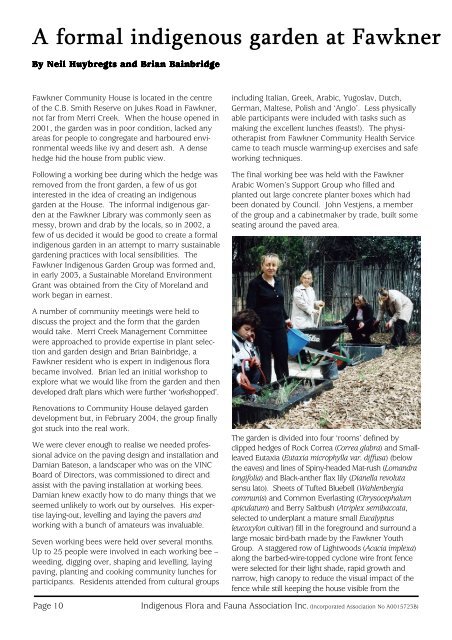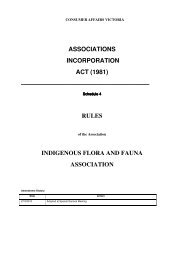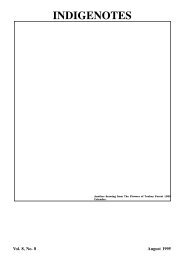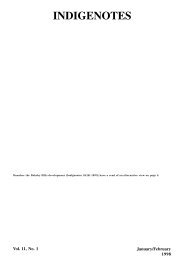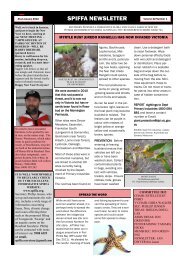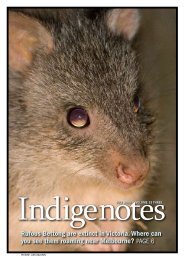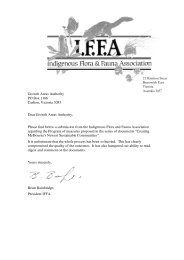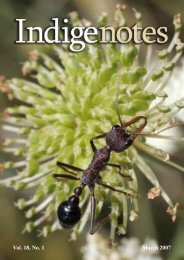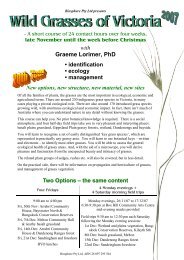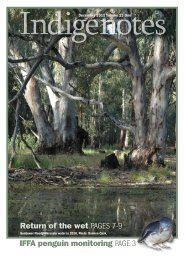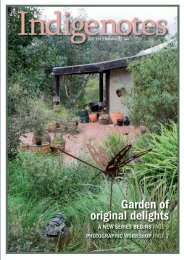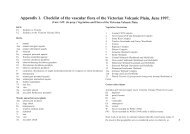Vol. 17, No. 2 September 2006 - Indigenous Flora and Fauna ...
Vol. 17, No. 2 September 2006 - Indigenous Flora and Fauna ...
Vol. 17, No. 2 September 2006 - Indigenous Flora and Fauna ...
Create successful ePaper yourself
Turn your PDF publications into a flip-book with our unique Google optimized e-Paper software.
A formal indigenous garden at Fawkner<br />
By Neil Huybregts <strong>and</strong> Brian Bainbridge<br />
Fawkner Community House is located in the centre<br />
of the C.B. Smith Reserve on Jukes Road in Fawkner,<br />
not far from Merri Creek. When the house opened in<br />
2001, the garden was in poor condition, lacked any<br />
areas for people to congregate <strong>and</strong> harboured environmental<br />
weeds like ivy <strong>and</strong> desert ash. A dense<br />
hedge hid the house from public view.<br />
Following a working bee during which the hedge was<br />
removed from the front garden, a few of us got<br />
interested in the idea of creating an indigenous<br />
garden at the House. The informal indigenous garden<br />
at the Fawkner Library was commonly seen as<br />
messy, brown <strong>and</strong> drab by the locals, so in 2002, a<br />
few of us decided it would be good to create a formal<br />
indigenous garden in an attempt to marry sustainable<br />
gardening practices with local sensibilities. The<br />
Fawkner <strong>Indigenous</strong> Garden Group was formed <strong>and</strong>,<br />
in early 2003, a Sustainable Morel<strong>and</strong> Environment<br />
Grant was obtained from the City of Morel<strong>and</strong> <strong>and</strong><br />
work began in earnest.<br />
including Italian, Greek, Arabic, Yugoslav, Dutch,<br />
German, Maltese, Polish <strong>and</strong> ‘Anglo’. Less physically<br />
able participants were included with tasks such as<br />
making the excellent lunches (feasts!). The physiotherapist<br />
from Fawkner Community Health Service<br />
came to teach muscle warming-up exercises <strong>and</strong> safe<br />
working techniques.<br />
The final working bee was held with the Fawkner<br />
Arabic Women’s Support Group who filled <strong>and</strong><br />
planted out large concrete planter boxes which had<br />
been donated by Council. John Vestjens, a member<br />
of the group <strong>and</strong> a cabinetmaker by trade, built some<br />
seating around the paved area.<br />
A number of community meetings were held to<br />
discuss the project <strong>and</strong> the form that the garden<br />
would take. Merri Creek Management Committee<br />
were approached to provide expertise in plant selection<br />
<strong>and</strong> garden design <strong>and</strong> Brian Bainbridge, a<br />
Fawkner resident who is expert in indigenous flora<br />
became involved. Brian led an initial workshop to<br />
explore what we would like from the garden <strong>and</strong> then<br />
developed draft plans which were further ‘workshopped’.<br />
Renovations to Community House delayed garden<br />
development but, in February 2004, the group finally<br />
got stuck into the real work.<br />
We were clever enough to realise we needed professional<br />
advice on the paving design <strong>and</strong> installation <strong>and</strong><br />
Damian Bateson, a l<strong>and</strong>scaper who was on the VINC<br />
Board of Directors, was commissioned to direct <strong>and</strong><br />
assist with the paving installation at working bees.<br />
Damian knew exactly how to do many things that we<br />
seemed unlikely to work out by ourselves. His expertise<br />
laying-out, levelling <strong>and</strong> laying the pavers <strong>and</strong><br />
working with a bunch of amateurs was invaluable.<br />
Seven working bees were held over several months.<br />
Up to 25 people were involved in each working bee –<br />
weeding, digging over, shaping <strong>and</strong> levelling, laying<br />
paving, planting <strong>and</strong> cooking community lunches for<br />
participants. Residents attended from cultural groups<br />
The garden is divided into four ‘rooms’ defined by<br />
clipped hedges of Rock Correa (Correa glabra) <strong>and</strong> Smallleaved<br />
Eutaxia (Eutaxia microphylla var. diffusa) (below<br />
the eaves) <strong>and</strong> lines of Spiny-headed Mat-rush (Lom<strong>and</strong>ra<br />
longifolia) <strong>and</strong> Black-anther flax lily (Dianella revoluta<br />
sensu lato). Sheets of Tufted Bluebell (Wahlenbergia<br />
communis) <strong>and</strong> Common Everlasting (Chrysocephalum<br />
apiculatum) <strong>and</strong> Berry Saltbush (Atriplex semibaccata,<br />
selected to underplant a mature small Eucalyptus<br />
leucoxylon cultivar) fill in the foreground <strong>and</strong> surround a<br />
large mosaic bird-bath made by the Fawkner Youth<br />
Group. A staggered row of Lightwoods (Acacia implexa)<br />
along the barbed-wire-topped cyclone wire front fence<br />
were selected for their light shade, rapid growth <strong>and</strong><br />
narrow, high canopy to reduce the visual impact of the<br />
fence while still keeping the house visible from the<br />
Page 10<br />
<strong>Indigenous</strong> <strong>Flora</strong> <strong>and</strong> <strong>Fauna</strong> Association Inc. (Incorporated Association <strong>No</strong> A0015723B)


